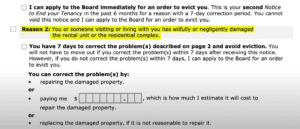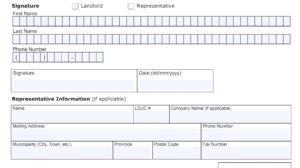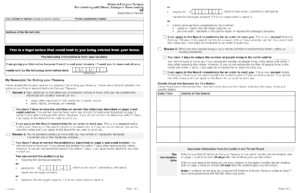For our audio-visual learners, here’s a 5-minute video on How to Serve an N5 form in Ontario.
Table of Contents
Understanding and Utilizing the N5 Form for Landlords
Hey everyone, Property Hustlers here! Today, we’re going to talk about a crucial topic for landlords: the N5 form. This form is your go-to document when addressing specific tenant issues such as interference with other tenants’ enjoyment, property damage, or overcrowding. Let’s unpack what the N5 form is, why it’s essential, and how to use it effectively.
What is the N5 Form?
The N5 form is a notice that landlords can serve to their tenants to evict or terminate a tenancy under particular circumstances. You might need to use this form if a tenant or their guest is disrupting the reasonable enjoyment of other tenants, damaging the property, or overcrowding. This form is versatile and covers many issues compared to other forms available to landlords.
Reasonable Enjoyment and Its Legal Background
Firstly, let’s talk about the concept of “reasonable enjoyment.” This term can be a bit tricky. It originates from the common law principle of quiet enjoyment, which obligates landlords to provide tenants with peaceful, undisturbed possession of their rental unit. This concept has evolved in legal terms but remains a cornerstone, ensuring tenants can live without unnecessary interference, barring essential maintenance or safety interventions.
Addressing Property Damage
When it comes to property damage, proving your case can be challenging. It often requires evidence like police reports, testimonies, or even video recordings. If you’re planning to file an N5 due to damage, you’ll typically ask the tenant to repair the damage or compensate for it. However, this doesn’t always guarantee a straightforward resolution.

Overcrowding Issues
Another reason you might use an N5 is overcrowding. Each city has specific bylaws defining what constitutes overcrowding—for example, Toronto’s bylaw limits occupancy based on room size. If you’re facing an overcrowding issue, and it’s backed by a city or fire department violation notice, the N5 form is your tool to address it.

Will an N5 Lead to Eviction?
Many landlords wonder if serving an N5 will lead to eviction. Generally, it’s unlikely, especially on the first attempt. In Ontario, the Landlord and Tenant Board (LTB) prefers to give tenants a chance to remedy the situation rather than displacing them immediately. If the issue isn’t resolved, landlords can then apply for eviction, but the process is designed to be fair and considerate, giving tenants ample opportunity to rectify the problem.
Filling Out the N5 Form Correctly
Filling out the N5 form accurately is crucial. Ensure all names match those on government IDs and the lease agreement. Document the reasons for serving the N5 meticulously, and be prepared to substantiate these claims at a hearing. Remember, the form is a two-step notice: the first serves to notify and allow for correction, and the second, if non-compliance continues, accompanies your application to the LTB.

Understanding Filing and Termination Dates
When serving an N5 form, it’s critical to adhere to the specific timelines for filing and termination dates. For first-time issuers within six months, the termination date must be at least 20 days after the service date. If you’re issuing a second N5 within this period, the termination must be set at least 14 days post-service. Remember, if you’re serving by mail, add an extra five days to accommodate mailing delays. This precise scheduling ensures legal compliance and supports a smoother process at the Landlord and Tenant Board.

Selecting the Correct Reasons and Documenting Details on the N5 Form
When you are preparing to serve an N5 notice, selecting the appropriate reason for the eviction notice is critical. Make sure the option you choose best reflects the specific circumstances that have arisen with your tenant. The form allows you to detail these reasons under the “Details of the Events” section, where you will need to thoroughly document the incidents that have occurred. This should include any efforts made to resolve the issues with the tenant. It’s essential that everything noted in this section can be substantiated in a hearing, as poorly documented claims can easily lead to a dismissal of your case. Finally, you’re going to finish the form off with personal or a representative’s details, such as full name, phone number, and signature.


Filing the Form and Following Through
The process starts with serving the first N5 notice based on the reasons you’ve documented. If the tenant fails to comply, you then serve a second N5 notice on the eighth day following the first. Subsequently, you’ll file with the Landlord and Tenant Board (LTB) using an L2 form. Remember, there is a $201 filing fee at the board, and you must use a certificate of service to document the delivery of all notices.
The final step is attending the hearing, where you’ll present your case. If the adjudicator finds the reasons compelling, they may issue an order for the tenant to comply. Should the tenant violate this order, you will then have grounds to apply for eviction.
Wrapping Up
Handling the N5 form and navigating LTB processes can be straightforward if done correctly, ensuring you cover all legal bases and properly document every step. If you have any questions about LTB forms or managing rental properties, don’t hesitate to reach out. We’re here to help and provide additional information as needed.
If you found this guide helpful, check out our other resources here. See you in the next update!
Start Your Investing Journey
Are you interested in real estate investing? Are you struggling with the high barriers to entry to the Canadian real estate market? Join us now and see how we can help you acquire your first US real estate deal in the next 45 days!
Fill out the application form below and take the first step towards expanding your investment portfolio across the border.






